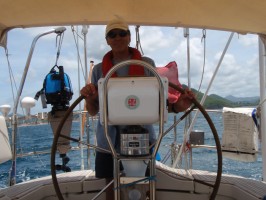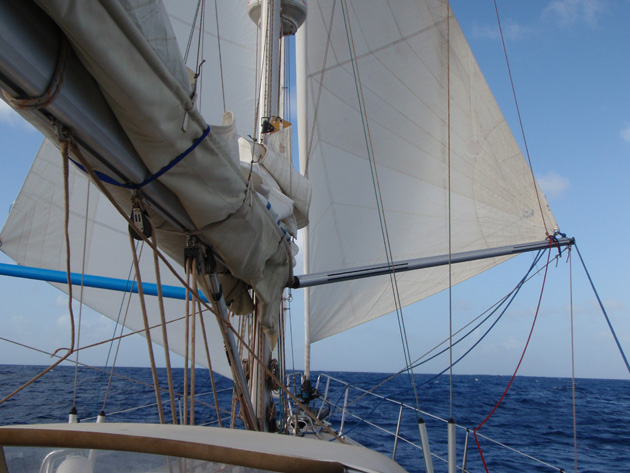When the rudder of his 39-footer broke in mid-Atlantic Patrick Marshall set up a jury rig, with the support and advice of a radio net, and sailed 1,500 miles to the Caribbean
 Amanda and I left Mindelo in the Cape Verde Islands at 1500 on Tuesday 6 December 2011 on our Sweden Yachts 390 Egret. We shot through the acceleration zone between São Vicente and Santo Antão in 30 knots of wind, and continued 50 miles south to avoid the islands’ huge wind shadow before turning west.
Amanda and I left Mindelo in the Cape Verde Islands at 1500 on Tuesday 6 December 2011 on our Sweden Yachts 390 Egret. We shot through the acceleration zone between São Vicente and Santo Antão in 30 knots of wind, and continued 50 miles south to avoid the islands’ huge wind shadow before turning west.
By midday the next morning we were heading direct for Barbados, 1,950 nautical miles away, with full main and the cruising chute set under a blue sky with just a few puffy clouds. That evening, while swapping the chute for a poled-out genoa, a large pod of dolphins came alongside and started performing antics for our entertainment.
Magellan Net
As usual, we took part in the evening Magellan Net over the SSB radio. This informal ‘sked’ was hosted by Fatty Goodlander, an entertaining US yachting writer whom we’d first met in Lanzarote and who was crossing the Atlantic in Wild Card on the final leg of a circumnavigation.
Any boat could report their position and talk about the important matters of the day, such as the quantity and size of fish caught or the sighting of whales. The morning net was more formal, with a roll call of all boats at sea, each giving their position, course, distance to go and wind and sea state. We were in contact with about 25 boats strung out across the Atlantic, with a few more already in the Caribbean and a dozen still in the Canaries or Cape Verdes.
On the fourth day, with freshening winds, we decided it was time to try our new tradewind rig: the genoa poled out on one side and a long-footed staysail poled out the other. We were delighted to find that the arrangement worked perfectly and Egret flew down the rhumbline, rock steady, at about seven knots. That evening we celebrated 1,500 miles to go to Barbados.
The joy of surfing down waves under a full moon ended abruptly with a metallic grating noise from below and the flogging of sails above as Egret lurched and careered off course. We thought at first that the autopilot had malfunctioned, but we couldn’t get her back under control so we hurriedly furled the sails and lay ahull to assess the situation.
Our next theory was that the linkage between the rudder shaft and wheel had failed, but when the emergency tiller fitted to the top of the shaft couldn’t steer either, we knew the problem was below the waterline.
The rudder’s gone!
Concerned that the force required to break the rudder could also have damaged the hull, we checked the bilge for water and inspected the area where the shaft penetrates the hull and were relieved to find nothing untoward.
By now it was daybreak, so we decided to have breakfast and a rest until 0900, when we would be able to report our predicament to the Magellan Net. At the start of the net the controller called for priority traffic. I piped up with the problem of our lost rudder. The response from other crews was encouraging, and the consensus was that we should deploy a drogue astern to steer the boat. Fatty immediately came up with detailed instructions on how to improvise one. We were asked to radio in every two hours.
Adapting their ideas to suit what we had on board, we made a drogue comprising an 8m rope bridle attached to the stern mooring cleats, followed in succession by a 12m warp, 4m of chain, our Bruce kedge anchor with a fender attached, a 4m warp, a fender, another 4m warp and fender, 4m of chain and a final fender. The total length of the drogue would have been about 32m.
Two 25m lines were shackled to the first chain and led to port and starboard through snatch blocks at the midships mooring cleats, then back to cockpit winches. These could be adjusted to maintain a straight course, and also, by pulling hard on one or the other, to tack or gybe.
Used for the drogue
3x 13m x 18mm dia warps
2x 5m x 14mm warp
2x 25m x 12mm steering lines (actually, our spinnaker sheets)
2x 4m lengths anchor chain
1x 15kg Bruce anchor
2x blocks (lashed to midships cleats for steering lines)
4x fenders
The next problem was to get Egret to sail downwind as opposed to her natural tendency to round up. The best she would do with a small headsail set was to sail on a beam reach, but eventually we got her to bear away to about 120° off the wind by setting a staysail to leeward and a small area of genoa hauled out to windward. We knew then that we would be able to get more or less where we wanted – eventually.
The wind and sea had been building all day, making work on deck quite demanding, but we had everything under control by the time we reported in to the evening net. John of Mary Anne II announced that they were sailing towards us to assist if required. Exhaustion helped us to sleep tolerably well during our off watches that night, and it was a huge relief to see a sail appear over the horizon early next morning.
Mary Anne II stayed in close proximity for the next 48 hours as winds continued unabated at 24 to 30 knots with confused 4m waves. We had been heading west-north-west, but the GRIB files suggested the weather would be kinder further south, so on the second morning we succeeded, at the third attempt, in gybing and heading south-south-west.
Sweden Yachts ride well to the seas, the cockpit was almost dry and the motion down below quite reasonable, so we were content to sit it out and rest until conditions improved. We were more concerned about Mary Anne II, especially as John had told us that green seas were regularly sweeping her decks and they had to keep changing between sailing and heaving to, to keep down to our speed.
Eventually we persuaded him that it would be safe for them to leave us and continue on their way.
A small piece of rudder intact
We had some good news after further examining the steering system when we detected a small amount of feel through the wheel. This could only mean that there was still a piece of the rudder intact, which would greatly assist steering once the weather calmed down.
Sweden Yachts rudders are supported by two ball-bearing races inside the hull and an external bronze shoe about a fifth of the way down the blade. The stainless steel shaft and tangs embedded into the glassfibre moulding are massively strong above the shoe, but somewhat less so below, designed so that the rudder would snap off under impact without damaging the housing or hull above – a not infrequent cause of total loss by sinking. It was reassuring to learn that the mode of failure had been exactly as designed.
During the next morning net, Peter of Norna told us that he had consulted ‘Herb’ – the legendary Atlantic weather forecaster – and received the advice that we should head south, a huge relief and confirmation of our tactics. Several boats astern asked if we needed anything, so we asked for more diesel, just in case we had to do a lot of motoring later.
First Awaroa kindly diverted to pass close by us, then Tsolo, but in both cases we had to abort a transfer owing to the conditions. By the sixth morning, wind and sea had eased sufficiently for us to set two small headsails poled-out and, at long last, we were able to point the bows directly at the Caribbean, 1,200 miles away.







